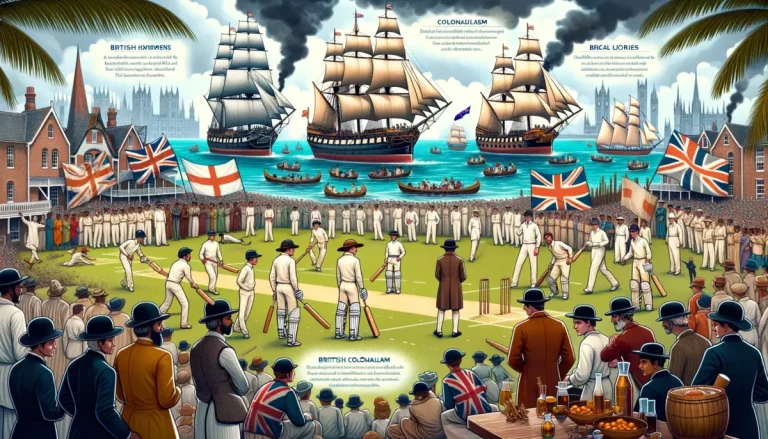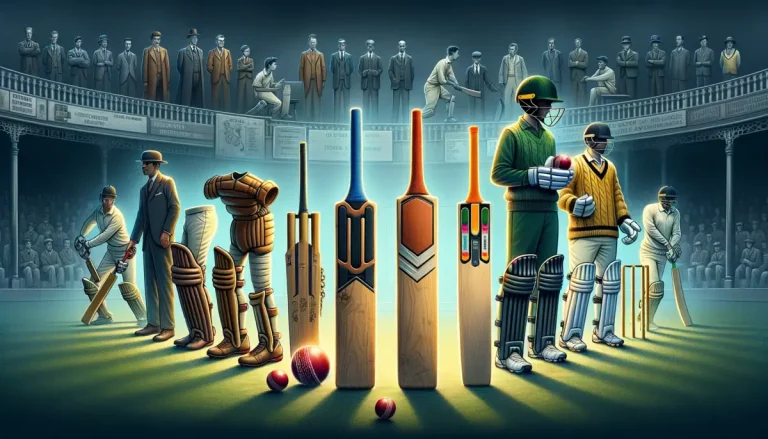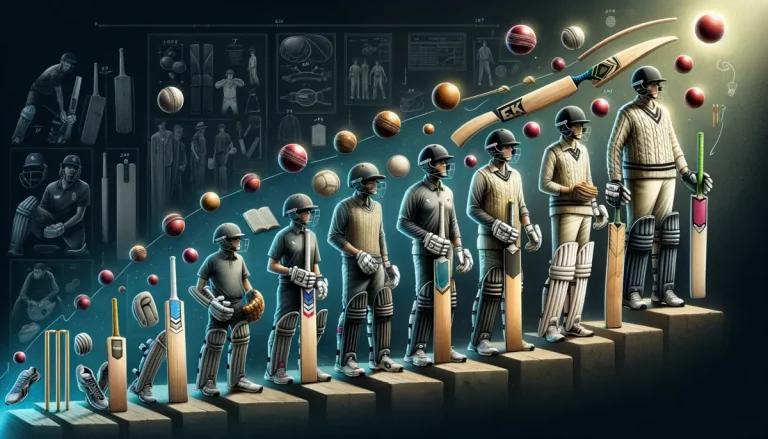Evolution of Cricket Rules in the Modern Era
Evolution of Cricket Rules in the Modern Era – Cricket, over time, has seen many changes to its rules. Starting from its simple beginnings, cricket has grown and changed to become the game we know today.
Article Highlights
Hide- The Marylebone Cricket Club (MCC) set out the early rules of cricket, which have evolved over time.
- Technological advancements, such as the Decision Review System (DRS), have brought a higher level of accuracy and fairness to the game.
- Limited-overs formats like One Day Internationals (ODIs) and T20 cricket have revolutionized the game, demanding higher levels of fitness and introducing new tactics and strategies.
- The modern era of cricket has seen debates and controversies surrounding the balance between bat and ball, as well as the preservation of traditional cricket.
In this article, we will cover:
Claim up to ₹15,000 Welcome Bonus Now
Claim up to ₹15,000 Welcome Bonus Now
- Easy Sign-Up and Deposits
- Fast deposits with UPI
- 300% Welcome Bonus up to ₹10,000
- The history and background of cricket’s rules.
- How playing techniques influenced rule changes.
- The addition of shorter game formats like limited-overs.
- How technology has played a part in updating the game.
Come with us to understand the rules of cricket better and to learn about some debates and controversies that have shaped the game recently.
Origins and Early Rules

The origins of cricket can be traced back to the 16th century, where the early rules of the game were primarily based on the laws set out by the Marylebone Cricket Club (MCC).
The evolution of cricket equipment and the influence of colonialism played significant roles in shaping the game during its early years.
Cricket equipment has come a long way since its inception. In the early days, bats were flat and curved, resembling hockey sticks, and were made of willow.
Over time, the shape evolved to the familiar form we see today, with a round face and a thick, curved blade. Similarly, the cricket ball has undergone changes, from being hand-stitched with four pieces of leather to the current standardized red leather ball.
Origins and Transformation of Cricket Formats: From Test to T20
Origins and Transformation of Cricket Formats: From Test to T20 – Cricket has changed a lot ... Read More
Colonialism had a profound impact on the growth and spread of cricket. British colonizers introduced the sport to their colonies, including India, South Africa, and the West Indies.
Cricket became a symbol of power and prestige, and its popularity spread rapidly in these regions. The sport provided an avenue for the locals to challenge their colonial rulers and assert their identity, leading to the formation of national cricket teams.
Development of Batting and Fielding Techniques
One significant aspect in the evolution of cricket rules in the modern era is the development of innovative batting and fielding techniques.
These techniques have been shaped by various factors, including innovations in cricket coaching and the impact of T20 cricket on batting and fielding strategies.
Innovations in cricket coaching have played a crucial role in enhancing batting and fielding techniques. Coaches have introduced new training methods, such as video analysis and data-driven insights, to help players improve their skills.
They focus on refining techniques, developing power-hitting abilities, and enhancing agility and reflexes in the field. This has led to a more dynamic and aggressive style of play.
The advent of T20 cricket has revolutionized batting and fielding strategies. The fast-paced nature of the format demands quick thinking, innovative shot-making, and agile fielding.
Batsmen have become more aggressive, employing unorthodox shots like the switch-hit and ramp shots to score runs quickly.
Fielders have to be highly athletic, using diving saves, acrobatic catches, and sharp throws to restrict the opposition’s scoring.
The impact of T20 cricket has also influenced fielding positions and strategies. Teams now employ specialized fielders in key positions, such as deep midwicket and backward point, to counter specific batting strokes.
Captains use innovative fielding placements to create pressure on the batsmen and force them into making mistakes.
Introduction of Limited-Overs Formats
Limited-overs formats have transformed the game of cricket in the modern era. With the introduction of One Day Internationals (ODIs) in the 1970s and subsequently Twenty20 (T20) cricket in the 2000s, the game has witnessed a significant shift in dynamics. These shorter formats have had a profound impact on player fitness and the evolution of strategies.
The fast-paced nature of limited-overs cricket demands a higher level of fitness from players. In ODIs, where each team has 50 overs to score runs, players need to be agile, quick on their feet, and possess excellent stamina to bat or bowl throughout the innings.
Similarly, T20 cricket, with its 20 overs per side, requires even greater athleticism and explosiveness. Players have had to adapt their training regimes to become more physically fit and agile, ensuring they can perform at their best in these shorter formats.
The introduction of limited-overs cricket has also brought about a revolution in cricketing strategies. In the longer format of the game, teams emphasize patience, building partnerships, and accumulating runs over time.
However, in limited-overs cricket, the focus shifts towards quick scoring and aggressive play. Batsmen now employ innovative shots and take more risks, while bowlers experiment with variations and try to restrict the opposition’s scoring.
Captains and coaches have had to develop new tactics and game plans to succeed in these formats, leading to the evolution of strategies that prioritize quick scoring and strategic field placements.
Role of Technology in Rule Changes
Technology has played a significant role in shaping and modifying cricket rules in the modern era. The introduction of technology has revolutionized the way the game is played and officiated, leading to more accurate decision-making and fairer outcomes.
One of the most notable technological advancements in cricket is the Decision Review System (DRS). This system allows teams to challenge on-field decisions by referring them to the third umpire, who uses various technological aids to make an informed decision.
The impact of DRS technology has been immense, as it has reduced the number of incorrect decisions made by on-field umpires and has provided players with a fair chance to challenge decisions.
Another technological innovation that has had a profound impact on rule changes in cricket is the use of Hawk Eye in LBW (Leg Before Wicket) decisions.
Hawk Eye is a ball-tracking technology that uses complex algorithms to predict the path of the ball and determine whether it would have hit the stumps.
This technology has been instrumental in helping umpires make accurate LBW decisions, eliminating the element of human error and providing a more objective assessment of the ball’s trajectory.
To summarize, the role of technology in cricket rule changes cannot be overstated. The introduction of DRS technology and the use of Hawk Eye in LBW decisions have brought about a higher level of accuracy and fairness in the game, ensuring that the outcomes are based on the correct interpretation of the rules.
This technological advancement has empowered players and spectators, enhancing the power dynamics within the game and reinforcing the credibility of cricket as a sport.
Modern-Day Cricket Rules and Controversies
Amidst the ever-evolving landscape of modern cricket, controversies surrounding the rules continue to stir debates and discussions.
One of the most contentious issues in recent years has been the implementation of the Decision Review System (DRS) and its impact on umpire decisions.
The DRS was introduced to reduce errors in umpiring decisions by allowing teams to challenge on-field decisions.
However, the system has been marred by controversy, with many questioning the accuracy and consistency of the technology.
Critics argue that the system is not foolproof and can still produce incorrect results, leading to further debates on its effectiveness.
Another significant aspect of modern-day cricket is the rise of T20 cricket and its influence on traditional rules and strategies.
The fast-paced nature of T20 cricket has led to a shift in tactics, with teams adopting aggressive batting approaches and innovative bowling techniques.
This has resulted in a change in the way the game is played, with a greater emphasis on power hitting and the use of spinners in the middle overs.
However, these changes have also sparked debates about the balance between bat and ball, as well as the preservation of the traditional skills of the game.
Some argue that T20 cricket has led to a decline in the art of Test cricket, where patience, technique, and strategy are paramount.
Which Evolution of Cricket Rules that You are More Familiar with?
In conclusion, the evolution of cricket rules in the modern era has been influenced by various factors such as the origins and early rules, development of batting and fielding techniques, introduction of limited-overs formats, and the role of technology.
Get up to ₹20,000 Bonus Every Week!
Get up to ₹20,000 Bonus Every Week!
- Fastest Indian Rupees Withdrawals
- Win 1000x Bet Amount!
- 450% Bonus up to ₹1,000,000
These changes have shaped the game into what it is today, with a focus on fairness, skill, and entertainment.
Despite controversies surrounding some rule changes, cricket continues to adapt and evolve to meet the demands of the modern game.








